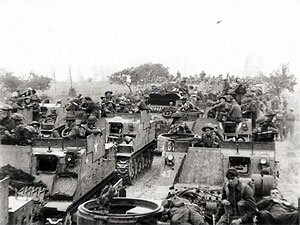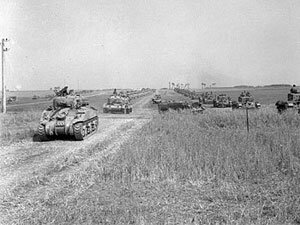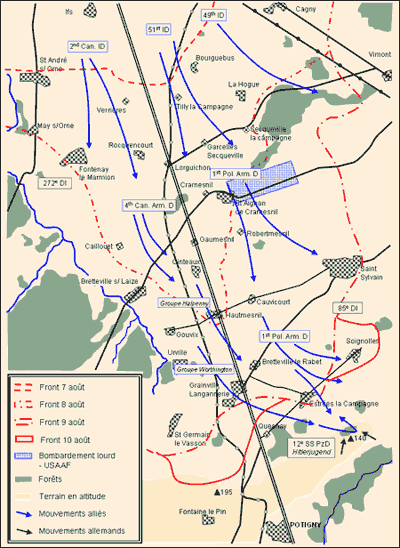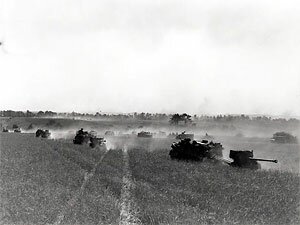The battle
Totalize - Tractable: Canadians on the road to Falaise
An innovative plan
 August 7, 1944 - the Canadian infantry get ready for the attack,
August 7, 1944 - the Canadian infantry get ready for the attack,
transported in Kangaroos. NAC, PA-129172
If it wished to keep pace with Americans, who on this date were approaching Laval, British 21st Army group had to resume its advance.
- To the west, following Bluecoat offensive, the British 2nd Army was slowly driving German units back.
- To the east, the displacement of four German panzer divisions which were supposed to take part in operation Lüttich, did not leave much in terms of elite troops except for the 12th SS-PzD Hitlerjugend standing on the way of 2nd Canadian Corps to Falaise.
To take advantage of this situation after the bloody failure of operations Atlantic and Spring, Montgomery decided to resume the offensive on Falaise in the Canadian sector. Planning of the offensive was entrusted onto Lieutenant General Guy Simonds, a 40-years old Corps commander, who was considered by Montgomery as a master of military strategy. Indeed, Simonds’ plan, backed by overwhelming numerical superiority, was quite innovative, audacious and eager to succeed.
First, the quantity of troops assigned to this operation was quite impressive. Whereas Germans forces were limited to the depleted 12th SS-PzD and freshly arrived 85th and 89th infantry divisions, the 2nd Canadian Corps (Canadian 2nd and 3rd infantry, Canadian 4th and Polish 1st Armoured Divisions) had been reinforced by 51st Scottish Infantry Division.
Second, two innovative techniques were to surprise the Germans. To ensure the presence of infantry, which had been missing at the time of preceding operations, this time the infantry would be transported through the battlefield in disarmed armoured vehicles, called “Kangaroos”. To create a surprise, Simonds opted for a night attack. While AA searchlights ensured coherence of the night attack and provided an “artificial moonlight”, the series of automatic guns would indicate to the engaged troops the general direction of the attack. Last, two air strikes, first one by RAF’s night heavy bombers, and second, during next afternoon by the 8th Air Force, were scheduled to sweep German positions.
The 2nd Canadian Corps on the road to Falaise
 August 8, 1944 – 10th PSK, 1st Polish armoured division, prepares
August 8, 1944 – 10th PSK, 1st Polish armoured division, prepares
to enter action. IWM, B-8835
The operation was launched late in the night of August 7th, immediately after 1019 Lancasters and Halifax bombers had released their deadly loads over adverse positions. Simonds’ plans went awry when it appeared that the air raid raised clouds of dust obstructing all visibility. Despite this backfire, the 51st Highland Infantry Division managed to advance quickly towards south, capturing Garcelles and Cramesnil at dawn. The 2nd and the 5th Seaforth were stopped short of Tilly by efficient defense of the 85th Infantry Division, before some reinforcement from the 144th brigade helped to break through German lines.
On the western flank, the 2nd Canadian Infantry Division exceeded its assigned objectives and took Rocquencourt, then, at dawn, May-sur-Orne, while sustaining only limited losses. Fighting for Fontenay-le-Marmion occurred to be more difficult. Having to face the enemy armor, the Camerons of Canada supported by the South Saskatchewan Regiment captured the ruins of the city in the afternoon of August 8th. At that time, German lines were deeply rammed, and it appeared to Simonds that time has come to throw his armoured divisions into the battle.
However, the situation on August 8th at midday had evolved in an unfavourable direction. The night, which allowed to lessen the advantage of the German tanks over Shermans, had turned into a sunny day, exposing allied troops positioned in the open to the enemy artillery observers, tanks and AT guns crews. Furthermore, the weakening defense of German divisions was suddenly reinforced by the arrival of Hitlerjugend, which was previously left in reserve. Lastly, the US air raid, which was to precede the attack, partially failed. Poor accuracy resulted in bombs spreading all over the battlefield, accidentally hitting the rearguard of the armoured divisions massed for the attack, and thus causing numbers of casualties.
Hence, when the allied tanks began to advance on the flat plain, they were quickly taken apart by concealed German AT guns. Cramesnil and Cinteaux were liberated, but only after a long and costly fighting, which had nothing to do with the previous progression. The Kampfgruppe Waldmuller, gathering its last tanks, was forced to a slow retreat but still inflicted serious losses to the Poles. The 4th Canadian Armoured Division advanced on the right flank, but stalled shortly after. For both contenders, it appeared that Simonds’ attack was loosing its momentum. 
Wishing to regain initiative after the disappointing afternoon of August 8th, the commander of the 4th Canadian Armoured Division, general George Kitching, prepared a night attack. He formed two combat groups: the Halpenny force was to attack Bretteville-le-Rabet, while the Worthington force aimed at the Hill 195. Progressing in the darkness, Worthington reached the Hill 140 instead of Hill 195, and went straight into the lines of the Hitlerjugend! In the morning of August 9th, the Canadians were encircled by the Panthers and Tigers, and then bombed by mistake by their own aviation while trying to withdraw. It was only in the late afternoon that a charge of the 1st Polish Armoured Regiment reached the few survivors of the Worthington force and allowed them to return in the allied lines. The Canadians were leaving no less than 47 tanks and 240 men on the Hill 140.
On its side, the Polish division was advancing slowly, capturing Cauvicourt and Saint-Sylvain nevertheless loosing tens of tanks due to the accurate enemy fire. Despite the eagerness of Polish troops, their Shermans were simply no match for the skilled Panthers and Tigers crews, and skillfully concealed AT guns. Another reason for this slow advance was lack of experience of Polish units, which were losing time to annihilate isolated German positions instead of circumventing them to reach the main defensive line.
On August 10th, Simonds launched his 4th armoured division, fairly exhausted by now, to the Quesnay wood, which was barring the way to the Laison River. This move developed into bloody failure resulting in more than 150 casualties for the 8th Canadian Brigade. Despite the fact that 1st Polish Armoured and the 3rd Canadian Infantry divisions had advanced in the direction of the Laison, far beyond Estrées and Soignolles, Simonds cancelled all further moves. Operation Totalize finally ended, leaving Canadian Corps less than 12 km from Falaise. In addition to the seized ground, operation “Totalize” was the occasion to claim a symbolic prize – on August 8th, Michael Wittman, the leading Ace of the Panzerwaffe with over 120 victories on his account, the man who made life difficult for British 7th Armoured Division at Villers-Bocage, found his death in his Tiger during a missed counter-attack.
Tractable: Canadians reach Falaise
In spite of the relative failure of Totalise, situation of the German forces in Normandy was becoming critical. After having taken Laval on August 6th, Patton and his 3rd Army had liberated Le Mans on August 9th. The next day, 15th US Corps of 3rd US Army deviated from its eastern course and turned north, on Alençon, where German forces were reduced to the sole 9th PzD, seconded by negligible 708th infantry division. A “Panzergruppe Eberbach” (remains of 1st SS, 2nd and 116th PzD) initially supposed to renew the counter-attack against Mortain was being organised against this new threat, but it was still too few too late to hope that it would stop the American drive north.
 August 14th, 1944 - Operation Tractable: the Canadians progress
August 14th, 1944 - Operation Tractable: the Canadians progress
in the plain of Falaise. NAC, PA-11653
For allied high command, despite recurrent lack of communication between British and American headquarters, it became clear that a surrounding operation could take place. After having initially planned to entrap German armies on the Seine, Montgomery decided to carry out such an operation on an axis Falaise - Argentan. In accordance to this plan, 2nd Canadian Corps prepared a new operation in direction of Falaise, while 15th American Corps (79th and 90th infantry, 5th armored division) strengthened by 2nd Free French armored division would progress towards Alençon then Argentan.
The new operation of the 2nd Canadian Corps, Tractable, was to release Falaise and reach the Americans. It was planned as a frontal attack, most of the thrust being aimed west and east of the Caen – Falaise road, while 1st polish and 4th Canadian armoured divisions would try to exploit the previous advance to the Laison and to break southeast. The operation was all but a surprise to the Germans, who ambushed the previous day a Jeep with a Canadian officer, carrying the plans of the forthcoming attack…
Tractable started on August 14th, after an air raid of 800 Lancasters and Halifax from RAF Bomber Command had bombed enemy lines. Again, many bombs felt on friendly positions, causing some 400 casualties among Canadian and Polish troops. First tanks rolled on soon after surrounded by artificial smoke and dust. German defences, even concentrated on the exact directions of developing attacks, were now too weak to stop the attack. Canadians reached then crossed the Laison between Assy and Maizières, Potigny felt to polish tankers in the afternoon.
Counter-attacks of some Tigers (102. s. SS-PzAbt) stalled the advance 6 km from Falaise in the evening, but it resumed the following day: Canadian 4th brigade reached Soulangy after tough fighting; Polish 3rd brigade found the Quesnay wood fled by its defenders; Canadian 7th brigade was fighting for Versainwhile. Finally, Falaise was reached August 16th, but it will take another day of heavy fighting before last SS defenders would surrender, August 18th.













 www.evl.pl
www.evl.pl